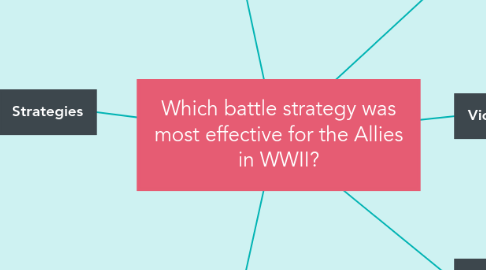
1. Allies
1.1. Axis
1.1.1. Germany
1.1.2. Italy
1.1.3. Japan
1.2. Allies
1.2.1. France
1.2.2. Great Britain
1.2.3. United States
1.2.4. Soviet Union
1.2.5. Canada
2. Strategies
2.1. Axis
2.1.1. Blitzkrieg
2.1.1.1. -Used motorized force concentration of tanks, infantry, artillery, combat engineers and air power.
2.1.1.2. -attempts to keep its enemy off-balance, making it difficult to respond quickly and efficiently
2.1.1.3. - Blitzkrieg operations were very effective during the campaigns of 1939–1941, especially after Germany invaded Poland.
2.2. Allies
2.2.1. Strategic bombing
2.2.1.1. -purpose was to undermine industrial production but demoralize the population.
2.2.1.2. -most significant: the dropping of the atomic bombs on Hiroshima and Nagasaki in 1945. USA used bombing raids to destroy Germany and Japan. But the benefit of using atomic weapons was that it impacted the conduct of war and relations with other countries in a permanent manner; even after WW2.
2.2.2. MI6 British Spies (espionage)
2.2.2.1. ‘Service Clarence’
2.2.2.1.1. A successful SIS network in Belgium during the war, led by Hector Demarque and Walthère Dewé. Throughout the war ‘Service Clarence’ provided valuable information on a wide range of enemy activity including coastal defences, the effects of Allied bombing and the location of German units.
2.2.2.2. The ‘Alliance’ Network
2.2.2.2.1. Was in France and was led by Marie-Madeleine Fourcade (SIS officer). The network was extensive – by August 1942, a breakdown of members listed 145 agents. It was a source of high quality and detailed intelligence on enemy troop movements, German order of battle, and Nazi secret weapons.
2.2.2.3. More info about the importance of the MI6
2.2.2.3.1. When the USA entered World War II, MI6 helped to train personnel of the U.S. Office of Strategic Services which is where they got the inspiration to create a Central Intelligence Agency (CIA).
2.2.2.4. Mikar
2.2.2.4.1. wireless station in Norway sent many messages to London reporting on the German occupying forces.
2.2.2.4.2. -run by Oluf Reed Olsen He reported on U-boat activity and German order of battle. His camp had to be well camouflaged to avoid detection and silence was important. Their vigilance paid off and they transmitted up to ten messages a day for over six months, without detection.
2.2.2.5. Sussex
2.2.2.5.1. men and women, working in pairs, were dropped behind enemy lines to provide front-line intelligence after D-Day. By August 1944, just two months after the invasion, over 30 teams were in France and they had transmitted over 800 messages.
2.2.3. Leapfrogging
2.2.3.1. -military strategy employed by the Allies in the Pacific War against Japan and the Axis powers during World War II.
2.2.3.2. Advantages: It would allow the United States forces to reach Japan more quickly and not expend the time, manpower, and supplies to capture every Japanese-held island on the way. It would give the Allies the advantage of surprise and keep the Japanese off balance.
2.3. Operation Most III???
2.3.1. Do more research...sounds interesting
2.4. Operation Biting???
2.4.1. Do more research...sounds interesting
3. Technical Innovations
3.1. Tanks such as the Panther (German) and the T-34 (Soviet)- ruled the ground
3.2. -sea equipment like sonar helped the Germans threaten the Allies with the U-boat without getting caught when aircraft carriers came on water.
3.3. -USA was the first to develop nuclear weapons (Little Boy) which was dropped on Hiroshima.
3.4. Rifles: Sturmgewehr 44: Rifle developed in Nazi Germany (Axis) M1918: light machine gun standardized by the US army in 1938 used up until Vietnam (Allies)
3.5. Aircraft: -Bell P-39 Airacobra USA -Hawker Typhoon Great Britain
4. Effects of WW2
4.1. The Soviet Union gained power over most of the European countries.
4.2. Among the estimated 45-60 million people killed were 6 million Jews murdered in Nazi concentration camps as part of Hitler’s diabolical “Final Solution,” now known as the Holocaust.
4.3. In total, there was about 50 million to more than 80 million deaths.
5. Victory
5.1. -Nazi regime collapsed in May 1945
5.1.1. Controversies about if Axis or Allies performed better or contributed more to the war.

